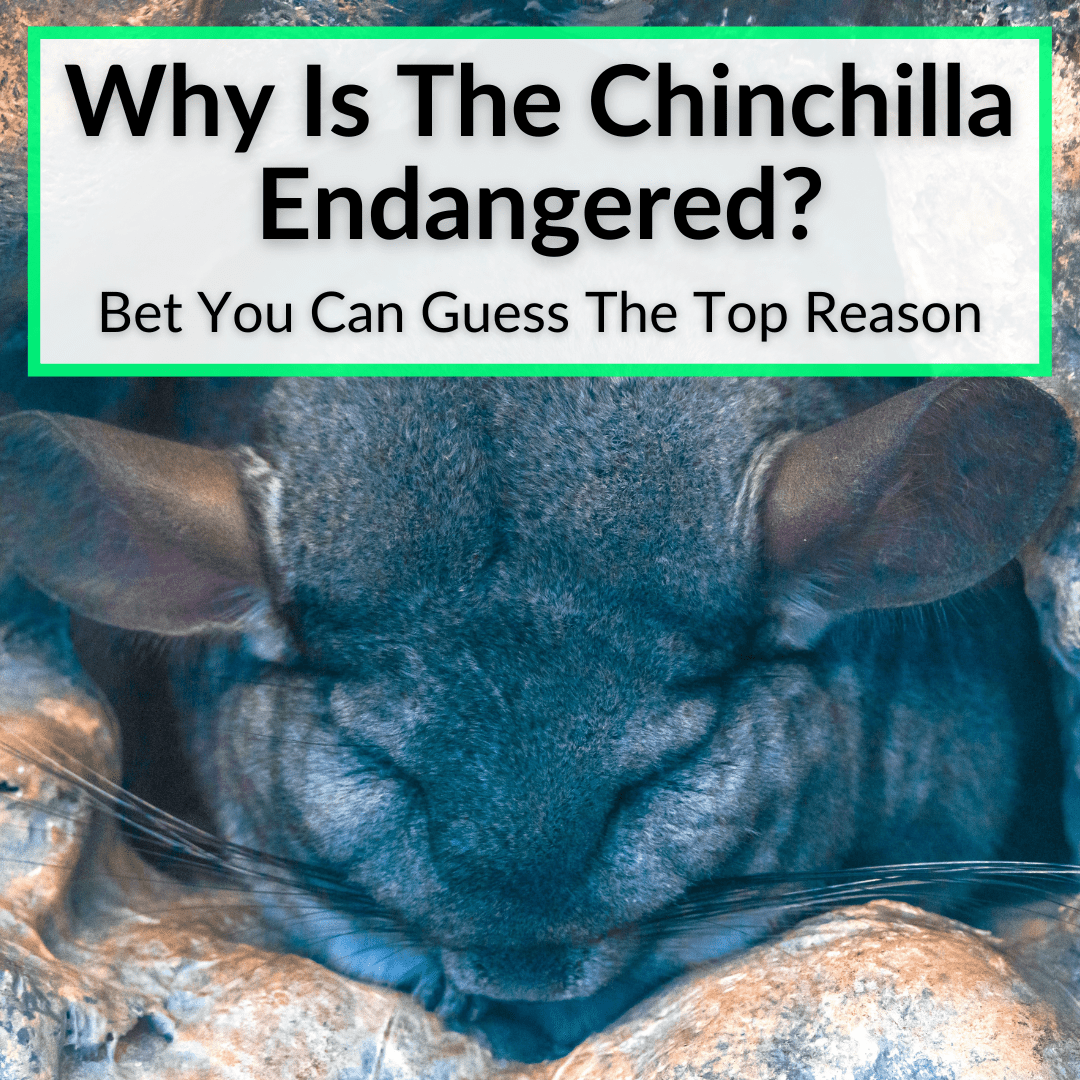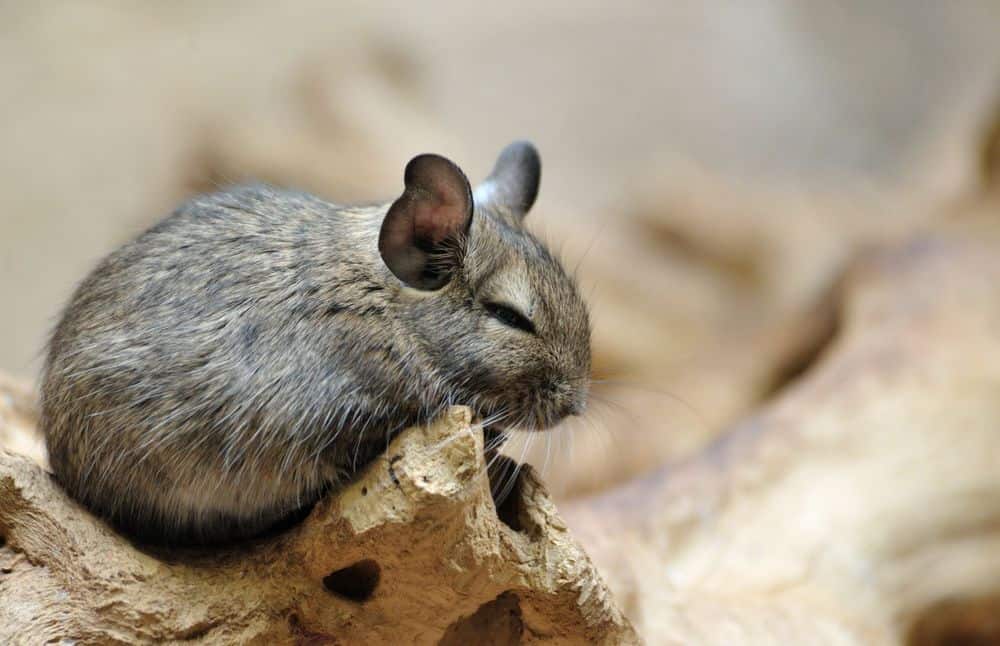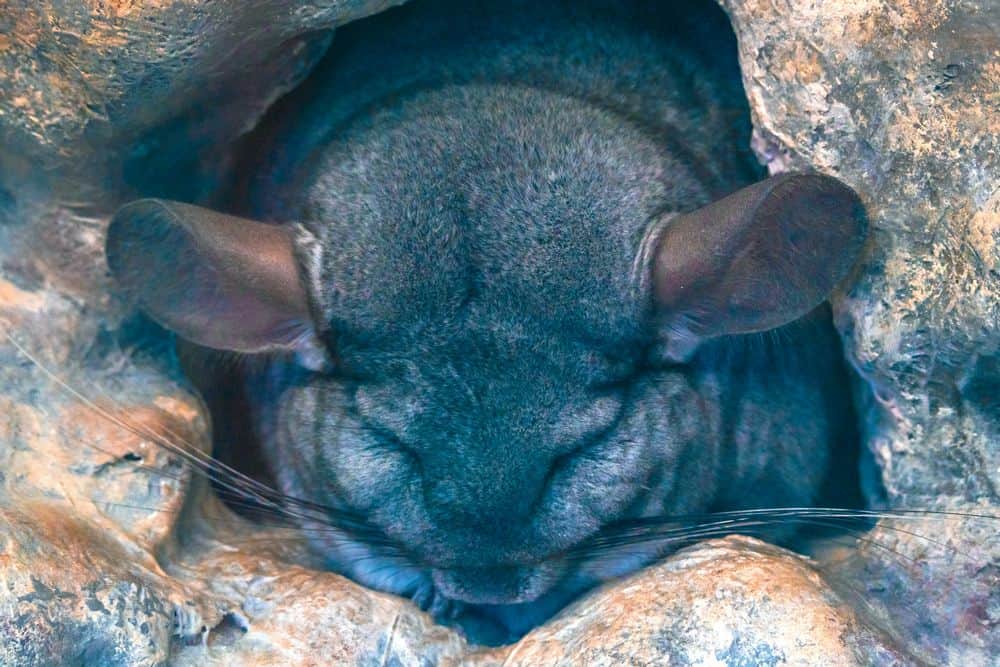
How sad is that!
You’re probably wondering how anyone could possibly want to hurt an animal so cute.
Or is the chinchilla endangered due to natural causes?
There are actually a number of different things driving the chinchilla toward extinction.
But they all have one factor in common. I bet you can already guess what that is.
Keep reading to find out the various reasons for the chinchilla’s endangered status and the one thing all of those reasons have in common.
Why Is The Chinchilla Endangered?
As you probably guessed, human activity is the reason chinchillas have become endangered. Farming and mining are destroying their habitats and poachers hunt them for their fur and their meat.
Chinchillas have been on the IUCN’s (International Union for the Conservation of Nature) red list since 2016 and have been endangered for the past fifteen years.
There has been a 90% drop in chinchillas in the wild over the past fifteen years. And even though laws have been put in place to protect the animals, not everyone likes to abide by them.

This means there’s a strong chance the species could become extinct within the next decade.
Habitat Destruction
As previously stated, humans are the main culprit for the chinchilla’s endangerment. The biggest reason for their population decline is habitat destruction due to farming and mining.
Chinchillas live in South America. They primarily live in the Andes mountains in the countries of Chile and Argentina. They also inhabit the Valdivian forests.
The forests are suffering deforestation, due to the encroachment of human civilization. We farm their land and we build towns, roads, and other infrastructure.
This results in the destruction of the chinchilla’s habitat and the elimination of their food sources, leaving them no choice but to flee. But they don’t adapt well to new habitats and end up dying.
The same also goes for mining. It also makes the chinchilla’s habitat uninhabitable, due to the earth being disturbed and vegetation wiped out. Mining also causes a lot of noise pollution, which further makes the area unlivable for the nervous and sensitive chinchilla.
Fashion

Fashion is also a contributor to the endangerment of chinchillas. These animals have some of the densest fur on the planet, with an average of sixty hairs to one follicle. That’s ten times the amount of us humans.
They have this incredibly thick fur to keep them warm in the cool, mountainous terrain they call home in South America. They need incredibly dense fur to keep them alive during those chilly months of the year. Chinchilla fur is the softest fur in the world, too. Or close to it.
But this fur comes with a big drawback. It makes warm and beautiful fur coats that are not prone to pest infestation, due to the thickness of the fur. It is also the softest This results in an extremely high price for chinchilla pelts.
And we all know what that means. Poachers.
Poachers hunt chinchillas for their luxurious fur. They get paid a lot for it, because customers are willing to pay insane amounts for a chinchilla coat. And these days, it’s not about warmth. It’s about status.
You may have seen a story recently about Floyd Mayweather buying a chinchilla coat for over $100,000. That’s the kind of person who buys them. Chinchillas die so that insecure people can attempt to prove that they are better than the rest of us.
How many chinchillas die to make such a coat?
In order to creating a standard-sized fur coat, 100 to 150 chinchillas need to die. That said, most coats are made from fur that comes from chinchilla farms. The animals still die, but they are not being killed in the wild.
However, given the large amount of money at play here, poachers have a lot of motivation to continue to hunt these cute little rodents in the wild. As long as they know there is a heavy reward waiting for them, they will happily kill any chinchilla they find, with no regard to their endangered status.
It is now illegal to hunt chinchillas, and most coats are made with fur from farms. But that does not stop poachers from going out to hunt the animals in their natural habitat.
Food

Can you eat a chinchilla? You certainly can. Fur is not the only reason people hunt chinchillas. Some also hunt them for food. Chinchilla meat is rich in monounsaturated fats and some cultures eaten it.
That said, we are talking about such small numbers here, that we almost didn’t mention this factor here at all. We ended up including it for completeness’ sake, but people eating chinchillas has had virtually no impact on their becoming endangered.
The main reason for the endangerment of chinchillas is habitat destruction due to mining and deforestation. When you destroy an animal’s habitat, you are take away its home and food supply.
This forces the animal to flee, usually to areas where they can not survive, either due to lack of appropriate food, inhospitable climate, or new predators.
If we keep expanding our civilizations into their habitats, chinchillas will soon be left with no place to go and no food to eat. At that point, the species will die out.
So now, you’re probably wondering what you can do to help.
What Can Be Done To Save Chinchillas?
Well, there are plenty of organisations that help with conservation efforts when it comes to finding new areas in which chinchillas can settle. You can join forces with, or donate to, Tulsa Zoo or Save the Wild Chinchillas, if you want to do your bit to help.
Tulsa Zoo has a project to restore the chinchilla’s habitat throughout Chile. They focus on restoring the ecosystem in Quebradas Cuyano, Zapallar, and Los Lioneras y Curico, which are the areas of greatest concern in the region.
How Many Chinchillas Are Left?
It is estimated that there are as few as ten thousand chinchillas left in the wild. Because they are classed as an endangered species, their habitats are protected by law. However, this does not stop hunters from poaching the small animals. It is also hard to keep track of hunting in remote areas of Chile and Argentina, which makes it difficult to put a stop to poaching.
What Threats Do Chinchillas Face?

Chinchillas face numerous threats, with the main ones being hunting and habitat destruction. However, they can also face threats from other animals.
Grazing cattle and goats can affect their habitat. If these animals are being farmed in a chinchilla’s habitat, then it’s going to leave them with little food for themselves, meaning they may be forced out of the area.
Are Chinchillas Going Extinct?
Yes, chinchillas are going extinct. They are on the IUCN’s red list for endangered species and could potentially go extinct within the next decade. This is due to human activity that has threatened the species for many years. Deforestation, mining, and hunting all play a major role in the decline of the chinchilla population.
The IUCN has even gone so far as to say they think the chinchilla population may even be too small to naturally repopulate now, even with protective measures in place.
Where Do Chinchillas Live?
Chinchillas live in South America, particularly in the mountains and plains of Chile and Argentina. You’ll most likely find them in the rocky Andes mountains usually between nine and fifteen thousand feet. Now, that’s a long way up!
They like it that far up, because there is plenty of rock cover and room to leap around. They’re able to live that far up the mountains due to their extremely thick fur which works at keeping the cold air away from their skin and stops them from shivering throughout the night.
Why Chinchillas Are Endangered: Final Thoughts
The various reasons the chinchilla has become endangered can all be summed up in one word: humans. We destroy their habitats, leaving them with no place to go and no food to eat.
We do it in a number of ways. We farm their land, we mine their land, we build infrastructure, and we even settle on their land and take it for ourselves. Plus, we hunt them, so we can show off with a unique coat that few people can afford.
Moncho Aldamiz says
DEAR X, I would like to thank you for this information about chinchillas, my daughter is very interested in chinchillas and is very interested in what you have written. And for that I thank you.
Jan Mahoney says
Is there a book I could order that would be a good reference for my daughter.. she loves all animals and has talked about a chinchilla for a long time.. I want to get her one for Christmas.. she keeps her house very cold and clean..